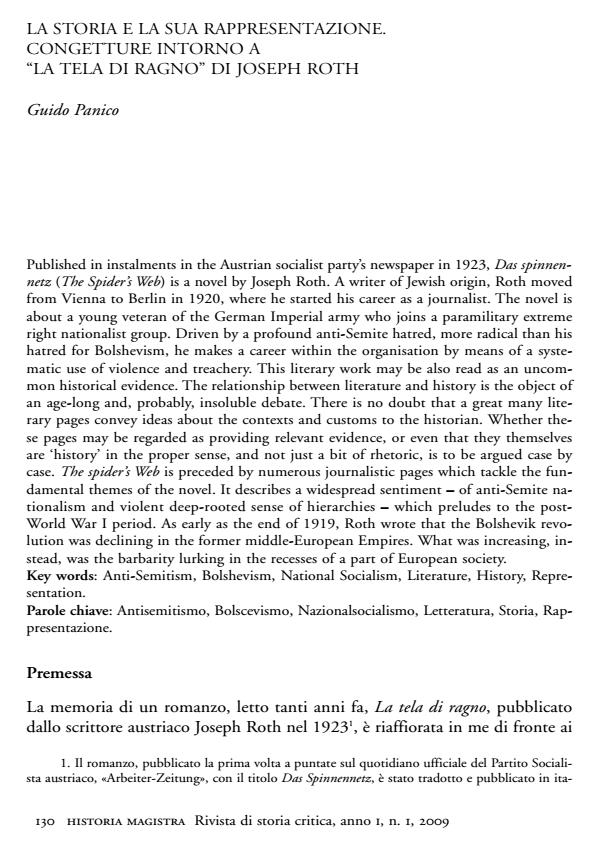La storia e la sua rappresentazione. Congetture intorno a "LA tela di ragno" di Joseph Roth
Journal title HISTORIA MAGISTRA
Author/s Guido Panico
Publishing Year 2009 Issue 2009/1
Language Italian Pages 17 P. 130-146 File size 126 KB
DOI 10.3280/HM2009-001014
DOI is like a bar code for intellectual property: to have more infomation
click here
Below, you can see the article first page
If you want to buy this article in PDF format, you can do it, following the instructions to buy download credits

FrancoAngeli is member of Publishers International Linking Association, Inc (PILA), a not-for-profit association which run the CrossRef service enabling links to and from online scholarly content.
La storia e la sua rappresentazione. Congetture intorno a "LA tela di ragno" di Joseph Roth - Published in instalments in the Austrian socialist party’s newspaper in 1923, Das spinnennetz (The Spider’s Web) is a novel by Joseph Roth. A writer of Jewish origin, Roth moved from Vienna to Berlin in 1920, where he started his career as a journalist. The novel is about a young veteran of the German Imperial army who joins a paramilitary extreme right nationalist group. Driven by a profound anti-Semite hatred, more radical than his hatred for Bolshevism, he makes a career within the organisation by means of a systematic use of violence and treachery. This literary work may be also read as an uncommon historical evidence. The relationship between literature and history is the object of an age-long and, probably, insoluble debate. There is no doubt that a great many literary pages convey ideas about the contexts and customs to the historian. Whether these pages may be regarded as providing relevant evidence, or even that they themselves are ‘history’ in the proper sense, and not just a bit of rhetoric, is to be argued case by case. The spider’s Web is preceded by numerous journalistic pages which tackle the fundamental themes of the novel. It describes a widespread sentiment - of anti-Semite nationalism and violent deep-rooted sense of hierarchies - which preludes to the post- World War I period. As early as the end of 1919, Roth wrote that the Bolshevik revolution was declining in the former middle-European Empires. What was increasing, instead, was the barbarity lurking in the recesses of a part of European society. Key words: Anti-Semitism, Bolshevism, National Socialism, Literature, History, Representation. Parole chiave: Antisemitismo, Bolscevismo, Nazionalsocialismo, Letteratura, Storia, Rappresentazione.
Guido Panico, La storia e la sua rappresentazione. Congetture intorno a "LA tela di ragno" di Joseph Roth in "HISTORIA MAGISTRA" 1/2009, pp 130-146, DOI: 10.3280/HM2009-001014